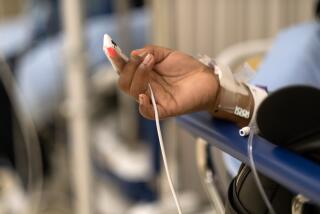Toxic Shock in Children Re-Emerging, Officials Say : Health: Many Civil War soldiers died from the complications of severe infections. Still rare in children, cases have become more common in the last five years, with a second reported in San Diego.
- Share via
The streptococcus bacterium that invaded the body of a young girl with chickenpox, provoking a toxic-shock reaction that led to the amputation of her arms and legs, has been found recently in other children, medical officials said Friday.
Dr. Benjamin Schwartz, with the Centers for Disease Control in Atlanta, said cases in which “strep” has triggered toxic shock in children have occurred elsewhere in the country recently, although none have been reported in medical literature.
“Obviously, something like this can cause a lot of panic,” Schwartz said. “Toxic-shock syndrome from streptococcus infections does occur in children, and has, although it’s very, very rare. They’re often related to wounds or other skin infections and occasionally occur following pneumonia.”
Doctors at Children’s Hospital said this week that the strain of streptococcus bacteria found in 6-year-old Jessica Lynn Esquivel had never been seen in a child in San Diego or in any documented case in the country.
Jessica, who was admitted April 1 with what was first believed to be a routine case of chickenpox, experienced full cardiac arrest, in addition to kidney, liver and respiratory failure. On April 18, her legs were amputated at the knee, and her arms at the elbow.
A kindergarten student from Imperial Beach, Jessica remains in critical condition in the intensive care unit of Children’s Hospital. However, Dr. Brad Peterson, the physician supervising her care, said he expects her to have full liver, kidney and respiratory recovery.
Meanwhile, another instance of a San Diego child incurring toxic-shock syndrome in conjunction with a case of chickenpox was reported to The Times and verified by Children’s Hospital on Friday.
Last fall, 3-year-old Lauren Arnsdorff had to have the tip of her index finger amputated and she suffered lung damage.
Dr. Marian Melish, professor of pediatrics at the University of Hawaii School of Medicine, said cases in which strep infections in children have led to serious and sometimes fatal consequences have occurred with greater regularity in the last five years.
Melish characterized their re-emergence as having a “ ‘Back to the Future’-like effect,” not unlike cases that were widely reported during the Civil War and in the 1910s and 1940s.
“Complications resulting from chickenpox--in which the child incurs a secondary bacterial infection--range from the trivial to the severe to the fatal,” said Melish, who once taught in the pediatrics department of the UC San Diego School of Medicine. “Streptococcus and staphylococcus bacteria are considered ubiquitous, meaning they’re everywhere and can enter a person’s body any time the skin is broken.
“If you’re one of the unlucky few to incur such an infection, the results can be devastating and often carry a grim inevitability. In other words, it’s very hard to rescue people from these things, especially when they lead to toxic shock.”
Melish said severe streptococcus infections were common during the Civil War, killing hundreds of soldiers, and later in history, especially the early part of the century.
For whatever reason, she said they’re beginning to re-emerge, particularly in cases of toxic shock. The lesions caused by chickenpox are just one way the bacteria can enter the body. She said any cut can serve as a gateway.
“We have a real ‘Back to the Future’-type link here,” Melish said. “We’re seeing a return to the type of strep as dangerous as those in the ‘40s, the 1910s, and earlier.”
The good news for parents, Melish said, is that a chickenpox vaccine is now in the hands of the Food and Drug Administration and may be licensed within a few years.
“Nobody knows how far away it is, but they (FDA researchers) seem convinced that it can be safe and effective,” she said. “I’d say it’s only a matter of time.”
Dr. Anne Schuchat, with the Centers for Disease Control, said toxic-shock syndrome, regardless of the cause, is “an uncommon occurrence,” having been reported, as an annual average, in “five cases per 1 million population.”
“Fifty-five to 60% of all toxic shock is menstrual toxic shock, the classic kind associated with tampons during a menstrual period,” Schuchat said. “The rest is associated with a number of conditions. These can occur in any time of skin lesion--boils, abscesses or pox-like sores.
“Toxic shock is quite rare, and having it associated with a single condition like chickenpox is extremely rare. We’ve had very few reports of pediatric toxic-shock syndrome.”
Nevertheless, Lynn Arnsdorff, a San Diego mother, said her 3-year-old daughter, Lauren, incurred toxic shock syndrome following chickenpox last fall.
Arnsdorff said Lauren, a patient at Children’s Hospital, ended up having the tip of her index finger amputated and incurred minor lung damage, mainly from prolonged exposure to the respirator needed to help her breathe during her stay.
Children’s Hospital officials confirmed this week that Lauren Arnsdorff was a patient and a victim of toxic shock.
“But the organism that caused the syndrome was different from that of Jessica’s,” said Mark Morelli, a hospital spokesman. “Lauren’s was a staphylococcus bacteria, rather than the streptococcus bacteria Jessica had. While the shock syndromes were somewhat the same, the organism that affected Jessica was far more virulent.”
Arnsdorff said her daughter, who had a high fever and was having seizures, was taken to Children’s on Sept. 8. Two nights later, the symptoms got worse.
“They told us she would not survive the day,” Arnsdorff said. “She had heart failure, swelling, she was totally puffed up. They put her on massive doses of heart medication, but her kidneys failed.
“Although she had the chickenpox, they think she might have gotten toxic shock as a result of a tiny little scrape on her toe--not a pox scrape, but one she had before,” although doctors aren’t certain of the cause.
“We shuddered when we heard about Jessica,” Arnsdorff said. “It was like this grim deja vu . We were told that it was so rare, in Lauren’s case; it might never happen again. But, of course, it did, and with this poor child (Jessica), it was much, much worse.”
More to Read
Sign up for Essential California
The most important California stories and recommendations in your inbox every morning.
You may occasionally receive promotional content from the Los Angeles Times.













